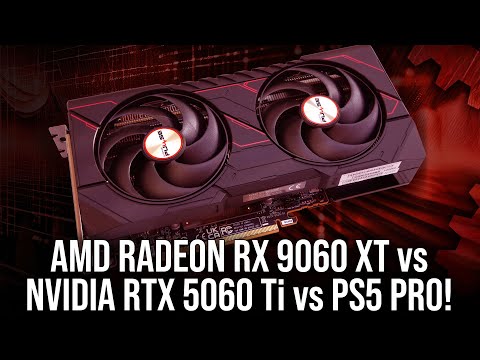AMD is looking to disrupt the mainstream GPU market with its RX 9060 XT in the same way that its xx70 class products caused so many problems for Nvidia’s RTX 5070 and RTX 5070 Ti. The formula is remarkably straightforward: attack the entry-level RTX 5060 by offering a similarly 8GB-equipped product with a lot more performance for the same price: $299. Meanwhile, AMD’s ambitions for its 16GB alternative are laudable. It may not be as fast as the RTX 5060 Ti, but it’s not that far off and it costs a whole lot less: $350 vs $430. In the UK, the RX 9060 XT prices are different, of course, with suggested retail prices of £270 for the 8GB model and £315 for the 16GB card.
While the era of gigantic gen-on-gen performance leaps are over, I’m happy that AMD is delivering a 16GB card at an affordable price-point, because right now, we simply cannot recommend 8GB cards. As our recent RTX 2080 Ti lookback demonstrated, Nvidia’s 2018-flagship has many advantages over the recently released RTX 5060. While performance is ballpark, the extra three gigs of VRAM alongside a full-size PCI Express interface gives the seven-year-old veteran advantages in triple-A games that the 5060 does not enjoy – especially when ray tracing is involved. The RX 9060 XT is more expensive than the RTX 5060, but it’s a lot cheaper than RTX 5060 Ti in both 8GB and 16GB iterations and not only that, it has the full-size PCIe bus that those cards lack, meaning minimal performance drops on older systems using the old PCI Express 3.0 standard.
On paper then, the RX 9060 XT 16GB addresses both of the irritating things that irked me with Nvidia’s latest 60-class offerings – but I cannot recommend the 8GB model for the same memory reasons that rule out two out of three of Nvidia’s alternatives. The RX 9060 XT has potent performance and decent RT capabilities – but what’s the point of them if you don’t have the memory to fully exercise the core hardware? Unhappily, AMD did not sample the 8GB version of the card – perhaps because it knows the kind of reception it would receive from a tech press that are mostly united about the need for 8GB cards to be shown the door.
In review today, we have the Sapphire Pulse version of the RX 9060 XT 16GB – and while the Pulse line is as cheap as it gets for Sapphire, I have absolutely no problem in recommending this card. It’s not overengineered: it’s small, it’s silent and requires a singular PCIe eight-pin power input. Display outputs are fine too, though the usual trio of DisplayPorts is cut back to two, although you still get an HDMI 2.1 output. Massive coolers and outrageous heatsink/fan combos simply aren’t needed for cards as frugal as this – and this one’s highly recommended.
Next up, let’s talk about the specifications of the RX 9060 XT and how it sits within the current RDNA 4 line-up. You can think of the 9060 XT as almost literally half a 9070 XT. 4096 shaders across 64 compute units becomes 2048 over 32. A 256-bit memory interface good for 640GB/s of bandwidth becomes 128-bit for 320GB/s. However, the 9060 XT’s TGP – total graphics power – is proportionately higher and clock speeds are also a good chunk faster.
Boost clocks and game clocks are good for official spec comparisons but the real world output definitely skews more towards the higher boost clock figure. I found that 2.9GHz to 3.3GHz was achievable when RT is not in play, with clocks reducing to 2.8GHz to 3.1GHz with challenging ray tracing workloads.
| AMD | RX 9070 XT | RX 9070 | RX 9060 XT |
|---|---|---|---|
| Stream Processors | 4096 | 3584 | 2048 |
| Compute Units | 64 | 56 | 32 |
| Boost Clock | 2.97GHz | 2.54GHz | 3.13GHz |
| Game Clock | 2.40GHz | 2.07GHz | 2.53GHz |
| ROPs | 128 | 128 | 64 |
| Memory | 16GB GDDR6 | 16GB GDDR6 | 8GB or 16GB GDDR6 |
| Memory Bus Width | 256-bit | 256-bit | 128-bit |
| Memory Bandwidth | 640GB/s | 640GB/s | 320GB/s |
| Total Graphics Power | 304W | 220W | 160W |
| PSU recommendation | 750W | 650W | 450W |
| Power connector | 2x or 3x 8-pin | 2x or 3x 8-pin | 1x 8-pin |
| Price | $599 | $549 | $299/$349 |
| Release Date | 6th March 2025 | 6th March 2025 | 5th June 2025 |
For our testing, we’ll be pairing the RX 9060 XT with our usual bleeding-edge GPU test rig, based around the fastest gaming CPU – the AMD Ryzen 7 9800X3D. We also have 32GB of Corsair DDR5-6000 CL30 memory, a high-end Asus ROG Crosshair X870E Hero motherboard and a 1000W Corsair PSU.
With all that said, let’s get into the benchmarks.
AMD Radeon RX 9060 XT Analysis
- Introduction and test rig [This Page]
- RT benchmarks: Alan Wake 2, Avatar: Frontiers of Pandora, Cyberpunk 2077
- RT benchmarks: Dying Light 2, F1 24, Hitman: World of Assassination
- RT benchmarks: Indiana Jones and the Great Circle, Metro Exodus Enhanced Edition, A Plague Tale: Requiem
- Game benchmarks: Alan Wake 2, Black Myth: Wukong
- Game benchmarks: F1 24, Forza Horizon 5, Senua’s Saga: Hellblade 2
- Game benchmarks: Hitman: World of Assassination, A Plague Tale: Requiem
- PCIe 3.0 vs PCIe 5.0: Black Myth: Wukong, F1 24, Indiana Jones and the Great Circle
- PlayStation 5 comparisons and DLSS 4 multi frame generation
- Conclusions, value and recommendations

